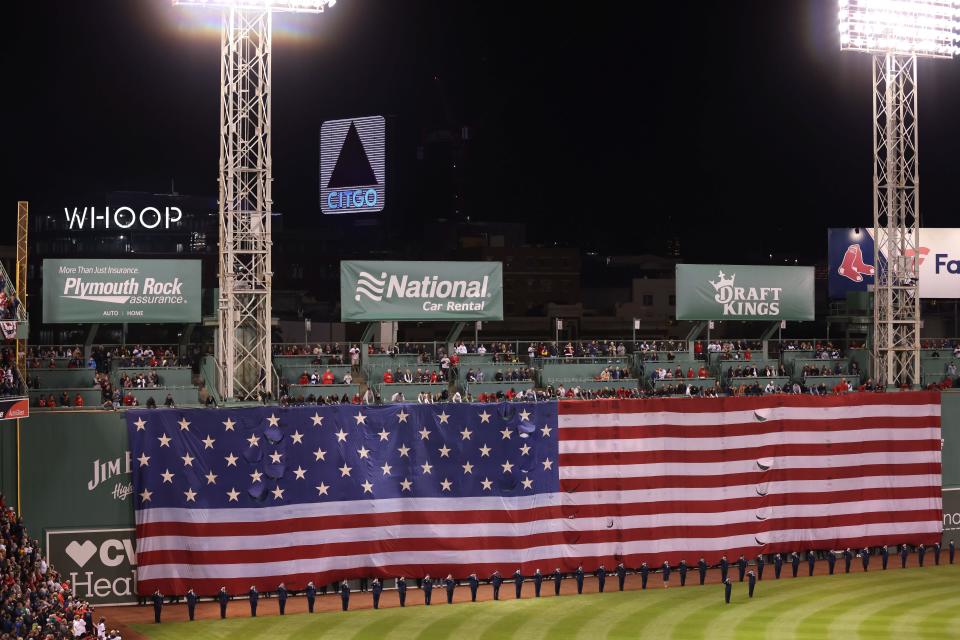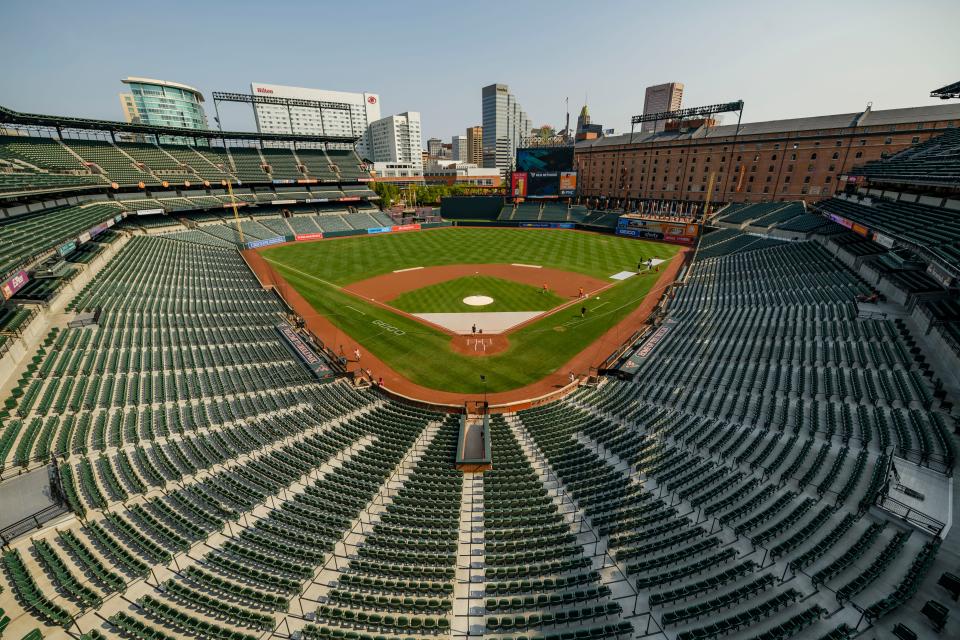'Baseball is not Bangladesh:' Why MLB survived the 1994 strike – and how it will outlast this lockout
- Oops!Something went wrong.Please try again later.
- Oops!Something went wrong.Please try again later.
- Oops!Something went wrong.Please try again later.
When Major League Baseball last self-immolated, cancelling its showcase event and keeping the game away from fans for nearly nine months, its recovery was boosted by a combination of determination and serendipity.
This time around, recovering from a lockout that’s only just beginning will take on a far different form, with smaller stakes but significant long-term implications.
The 1994-95 strike and work stoppage certainly accelerated a universe in which football – the NFL, most specifically – reigns supreme and everyone else forages for attention. Not that baseball wants for much: While the game frets about its diminishing cultural currency, it still enjoys annual revenues north of $10 billion, enough to keep owners and players happy – once they can settle on how to divvy it all up.
That prosperity seemed a long ways away in April 1995, when the game returned but many fans did not – attendance dropped more than 20% and those who did show up often displayed their ambivalence or disgust with the principals involved in the work stoppage.
The game, as it so often does, healed itself, with player-driven narratives combined with the league pulling as many levers as possible to boost interest, gain back fans and drive revenues.
Barely four months after the game returned in shame, Cal Ripken Jr. ostensibly saved baseball with his long-anticipated eclipsing of Lou Gehrig’s streak of consecutive games played.
Weeks after that, an expanded playoffs debuted, with a wild card October finally debuting after the 1994 labor strife delayed it a year.
Days later, Edgar Martinez and Ken Griffey Jr. saved baseball in Seattle.
In 1997, a third rail of sorts was touched with the debut of interleague play, further blurring the longstanding lines between American and National leagues and setting a course that decades later would have much of a younger generation simply refer to baseball as “the MLB.”
In 1998, Mark McGwire and Sammy Sosa, once again, saved baseball.
All the while, 19 new or significantly renovated ballparks were constructed between 1995 and 2010, benefiting from billions of dollars in public funding and providing lucrative playpens for franchises and aesthetically pleasing destinations for fans.
In a sense, the years following the World Series cancellation produced a fight-or-flight reaction within the game. Players met fans in the stands for pregame autograph sessions; Ripken stayed hours afterward to sign even amid the pressure of his streak. And commissioner Bud Selig, famously deliberate, continued relatively radical transformations until the end of his tenure, flip-flopping the Brewers and Astros between leagues and eventually adding a second wild card with two additional playoff games by 2012.

This time around, it will be far more difficult to measure the fallout – and recovery - thanks to several factors.
How long will this work stoppage last?
Will the rancor of collective bargaining negotiations jeopardize the ability of both sides to embrace significant changes to a game that is too slow and devoid of action?
Should the lockout extend into spring and imperil – or cancel – regular-season games, can the league bounce back after an extended absence in an entertainment landscape far more cluttered in 1995?
One thing seems clear: Baseball’s revenue boom in the wake of its darkest hour has created a sufficient firewall this lockout – whether measured in weeks, months or (gasp!) years – can only breach so much.
"Certainly, baseball is not in any form of trouble," says Rodney Fort, a professor of sports management at the University of Michigan and a past member of the International Association of Sports Economists advisory board who notes that the 30 franchises just came through two seasons of pandemic-stricken business with ease. "Maybe owners had to reach into their own pockets (during the COVID-19 stricken 2020-21 seasons), and they ended up firing (workers), anyway.
"And they still came through OK. Nobody came through poorly."
Naturally, a work stoppage – which began when owners imposed a lockout of players on Dec. 1 following the expiration of the collective bargaining agreement – is no way to grow an industry. And fans might not be so sympathetic to fill the stands after a self-inflicted wound compared to a pandemic-driven shutdown.
Yet a period of stagnation, be it brief or extended, after decades of booming growth is a far cry from the post-strike peril the game faced.

'Deciding to get well'
Fort has authored three baseball-centric books and in November 2000 testified before a Senate Judiciary Subcommittee on antitrust and business rights. The hearing was convened to examine the findings of one of Selig’s blue-ribbon committees, filled with the usual actors – Sen. George Mitchell, author George Will, Yale president Richard Levin and former Fed chairman Paul Volcker, with sportscaster Bob Costas and Selig also testifying.
The committee came to a conclusion one might imagine from a Selig-sanctioned exercise – that if baseball’s "current trend of competitive imbalance is not reversed," wrote Mitchell, "baseball’s status as an accessible, affordable and competitive spectator sport may be jeopardized."
As if on cue, 21 franchises would advance to the World Series over the next 21 seasons (in latter years, thanks in some part to increased revenue sharing). Nonetheless, Selig’s successor, commissioner Rob Manfred, has sounded similar sky-is-falling alarms in 2021, intoning in his "letter to fans" announcing the lockout that the MLB Players’ Association’s "vision for Major League Baseball would threaten the ability of most teams to be competitive."
Two decades later, Fort’s most vivid memory from that hearing is a statement from Will, the conservative commentator and avowed baseball fan who astutely noted the league’s worst enemy can often be itself.
"Baseball is not Bangladesh," Will said. "It is not poverty stricken. And it can get well by deciding to get well."
Industry revenues were at or approaching $11 billion entering the 2020 season and Fort believes simple economic stability and nominal population growth will drive it to $13 billion in coming years.
"Even if revenues stagnated," says Fort "gee, that only makes baseball like a $13 billion industry, and that’s if all it does is grow at the rate of inflation.
"Thirteen billion dollars is not hay, brother."
And that’s also why, regardless of the lockout’s length, recovering from it will take on a different form.

From contraction to expansion
MLB’s business model is far less reliant on attendance than it was in the 1990s. And it took a minute for that sector to bounce back.
Attendance fell from a pre-strike 1994 average of 31,256 to 25,021 in 1995. It did not top the 30,000 mark again until 2004, during which time new or refurbished ballparks opened in Cleveland, Detroit, Pittsburgh, Milwaukee, Houston, Anaheim, Seattle, Atlanta, Philadelphia, San Francisco, Cincinnati and Colorado.
Expansion teams were welcomed to Arizona and Tampa Bay, whose buy-in fees provided another windfall for owners.
Yet the industry angst was still such that in November 2001 owners voted, 28-2, to contract two franchises; the expected targets, the Montreal Expos and Minnesota Twins, cast the lone dissenting votes. Selig said both franchises had a "long record of failing to generate enough revenues to operate a viable major league franchise." A Minnesota court ruling determined the Twins had to fulfill the terms of their Metrodome lease, and the contraction gambit fell through, but not after much fretting in Minneapolis, Montreal, Oakland and both Florida markets, all of which fit Selig’s general description.
Minnesota and Oakland would win their divisions the following year and met in the 2002 AL Division Series. Florida won the World Series in 2003.
Now? Well, even with unsettled stadium situations in Oakland and Tampa Bay, MLB has its eyes on further expansion, with a clean eight-division, 32-team format in the offing and burgeoning markets such as Charlotte, Portland, Nashville and Montreal – redux – gearing up to lure a franchise.
National television deals valued at nearly $2 billion annually are coming online, and while the regional sports network model is wavering, franchises such as the Dodgers still have a decade or more to run on multi-billion dollar local contracts.
No, there’s little fear of going under. But disappearing further from sight risks disappearing from minds, too – particularly with a younger population that did not grow up with limited viewing options, and thus a Game of the Week or a must-see World Series as part of their rhythms.
The so-called TikTok generation may be something of a trope, as is the concept that our attention spans are narrowing, though that doesn’t lessen MLB’s visceral crises.
Among them: Courting a younger generation facing its own crises, particularly as they launch into adulthood in the wake of the Great Recession followed by COVID-19.
"Our viewing of sports has changed so much," says Lisa Masteralexis, senior associate dean and professor of sports management at the University of Massachusetts, "and I do worry about a younger generation that has so many more options. Will we lose them if it is a protracted, long labor battle (like) '94-95?
"With younger fans talking about their economic struggles - whether it’s an inability to buy a house, pay their student loans, get their own salaries at rates that are living wages - they have to be conscious of how it plays to their base so as not to alienate them."
Meanwhile, the embrace of gambling will open up another revenue stream, though, beyond official partnerships, its upside won’t be known for many years. There’s also some runway for MLB to finesse the streaming-RSN conundrum, with a significant maxim – that broadcast rights to live sporting events remain incredibly valued – on its side.
As for the lockout? It is not what you want, but it will not last forever. And even if it extends deep into 2022, and financial blows both real and intangible occur, there’s still plenty in the vault.
“So, if baseball only makes $11 billion in stead of $14 billion, do you expect owners will dump their teams for pennies on the dollar?" asks Fort. "I have a hard time conceiving of that, simply because of the fixation and interest of sports fans.
"Revenues may go down. But it’s not going to mean the end of sports world."
And perhaps it's better to have it all out now, even if it means a stoppage until players make the gains they feel were lost over the past decade.
One lockout, after all, is better than two.
"It’s almost like they have to go to war now and settle these issues," says Masteralexis, "so they don’t rear their heads again."
This article originally appeared on USA TODAY: MLB lockout: How baseball survived 1994 strike and will outlast this

